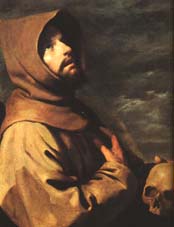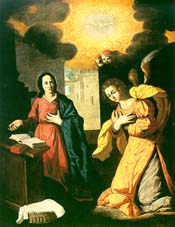Francisco de Zurbaran was born in 1598 in the village of Fuente de Cantos in the province of Badajoz, one year before Diego Velasquez. Zurbaran was probably of Basque descent and his parents, both peasants, sent him in 1614 to Sevilla where he became the apprentice of an obscur painter. He already showed some extraordinary talent at 18 after painting a Purissima though he did not study with the best Sevillan artists of his time, notably Pacheco.

St. Francis | 
The Annunciation |
He soon befriended Velasquez who was considered as the most promising Spanish artist.
After decorating the chapel of the San Pedro cathedral Zurbaran decided in 1625 to leave Sevilla to work in Llerena, near his native village. He got married there and had several children but continued to receive orders from Sevilla where he was invited to return in 1629.
At that time many Spanish religious congregations called on painters to glorify their deeds. Zurbaran thus produced several paintings for the Dominican convent of San Pablo, for the Magdalena church in Sevilla, for the convent of la Merced and scenes of the life of Saint Bonaventura now in the museums of the Louvre in Paris and Dresden.@@Zurbaran also painted many interesting portraits as well as the Apotheosis of Saint Thomas of Aquino, now in the museum of Sevilla.
Zurbarans fame reached Madrid thanks probably to Velasquez and the King asked him to decorate the new palace of Buen Retiro with a series of paintings. He thus produced the twelve labours of Hercules and the king was so much pleased that he called him The painter of the king and the king of painters.
Painter to the King in 1638, Zurbaran nevertheless thought that decorating palaces was boring and returned to the production of religious works notably for the monastery of Guadalupe adjusting contrast to natural light, creating a greenish visionary world with lightning effects. Zurbaran produced a gigantic work between 1628 and 1640 the year he lost his wife.
Zurbaran married another woman and had several children borne out from this marriage but then experienced difficult years. Forced to leave Sevilla, he went to Madrid where Velasquez once again came to his help.
But after 1640, he went on to paint less interesting religious works as if he had lost a great part of his genius. We know little about his last years except for the fact that he was still alive until 1664, the year of his death.
Still Zurbaran was a surprising painter who also produced some splendid still lifes in the style of Sanchez Cotan while certain heads of old men like those of St Peter, in Sevilla and of Saint Jerome in Guadalupe are reminiscent of the works of Ribera.
In fact Zurbaran was a self-taught artist who had a somewhat wild temperament due to his modest origins. He painted most of his works instinctively while he seemed at a loss at various times preferring to live in seclusion rather than to remain in the company of successful people.
Zurbaran painted simple themes which he would treat differently at will, mainly lonely saints in monastic robes juggling with light and shadows on the canvas and preferring light colours such as yellow, light blue and pink tones opposed to strong red, blue and green touches.
This painter also went for void and neutral spaces in an attempt to underline the meditative attitude of a sitter and to express a mental and strange world with a new association of images notably in his still lifes with bare fruits and objects that express some unbelievable magical power. Simplicity was in fact Zurbarans motto and he managed to turn it into something really acute thus pushing viewers to think more about the reality of daily life.
A.D